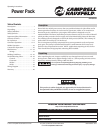
COMPRESSOR SAFETY
Never remove or attempt to adjust safety valve.
Keep safety valve free from paint and other
accumulations.
Never attempt to repair or modify
a tank! Welding, drilling or any
other modification will weaken the tank resulting in
damage from rupture or explosion. Always replace worn
or damaged tanks.
◆ Tanks rust from moisture build-up, which weakens the tank.
Make sure to drain tank regularly and inspect periodically for
unsafe conditions such as rust formation and corrosion.
\
Drain liquid from tank daily.
◆ Fast moving air will stir up dust and debris which may be
harmful. Release air slowly when draining moisture or
depressurizing the compressor system.
SPRAYING PRECAUTIONS
Do not spray flammable materials
in vicinity of open flame or near
ignition sources including the compressor unit.
◆ Do not smoke when spraying paint, insecticides,
or other flammable substances.
◆ Use a face mask / respirator when spraying and
spray in a well ventilated area to prevent health
and fire hazards.
◆ Do not direct paint or other sprayed material at the
compressor. Locate compressor as far away from the spraying
area as possible to minimize overspray accumulation on the
compressor.
◆ When spraying or cleaning with solvents or toxic
chemicals, follow the instructions provided by the chemical
manufacturer.
SAFETY STANDARDS AND SUGGESTED READING
ANSI Standard Z49.1 from American Welding Society, 550 N.W.
LeJune Rd. Miami, FL 33126
Safety and Health Standards
OSHA 29 CFR 1910, from Superintendent of Documents, U.S.
Government Printing Office, Washington, D.C. 20402
National Electrical Code
NFPA Standard 70, from National Fire Protection Association,
Batterymarch Park, Quincy, MA 02269
Safe Handling of Compressed Gases in Cylinders
CGA Pamphlet P-1, from Compressed Gas Association, 1235
Jefferson Davis Highway, Suite 501, Arlington, VA 22202
Code for Safety in Welding and Cutting
CSA Standard W117.2, from Canadian Standards Association,
Standards Sales, 178 Rexdale Boulevard, Rexdale, Ontario,
Canada M9W 1R3
Cutting And Welding Processes
NFPA Standard 51B, from National Fire Protection Association,
1 Battery March Park, P.O. Box 9146, Quincy, MA 02269-9959.
Practice For Occupational And Educational Eye And Face
Protection
ANSI Standard Z87.1, from American National Standards
Institute, 11 West 42nd Street, New York, NY 10036
Arc Welding and Your Health: A Handbook of Health
Information for Welding
From The American Industrial Hygiene Association, 2700
Prosperity Avenue, Suite 250, Fairfax, VA 22031-4319.
Cutting and Welding Processes
NFPA Standard 51B from National Fire Protection Association,
1 Battery March Park, P.O. Box 9146, Quincy, MA 02269-9959.
OSHA Hazard Communication Standard 29 CFR 1910.1200
OSHA General Industry Standard 29 CFR 1910 Subpart Q from
the Occupational Safety and Health Administration,
www.osha.org or contact your local OSHA office.
Applications Manual for the Revised NIOSH Lifting Equation
From The National Institute for Occupational Safety and Health
(NIOSH), 1600 Clifton Road, Atlanta, GA 30333
Refer to the Material Safety Data Sheets (MSDS) and the
manufacturers’ instructions for metals, electrodes, coatings and
cleaners.
SAVE THESE INSTRUCTIONS
DO NOT DISCARD
GR3000
Important Safety Information (Continued)
www.campbellhausfeld.com
5
The DANGER, WARNING, CAUTION, and NOTICE
notifications and instructions in this manual cannot
cover all possible conditions and situations that
may occur. It must be understood by the operator
that caution is a factor which cannot be built into
this product, but must be supplied by the operator.


















